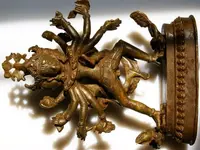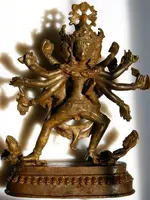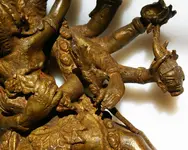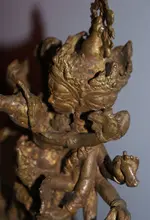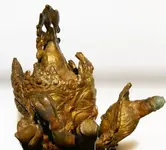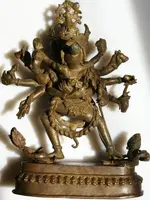Dear gleaner1,
thank you for the reply.
As I said, the statue is definitely a Buddhist statue, moreover it is a representation of a specific Buddhist deity (there are literally hundreds of such deities, all different from one another. Each has an exact number of hands, faces, legs, hand implements etc, i.e. is unique.)
May be a little history is appropriate to further clarify things.
Buddhism originated in India around 500B.C. and subsequently spread to most parts of Asia. Within Buddhism there are different traditions though, and those associated with the notion of deity have for the last 1200 years existed only in Nepal, Tibet, Bhutan, and parts of India and China.
In ancient times and nowadays this exact kind of statues were made only in these countries. It doesn't matter how old or new this statue is, there's no room for doubt - it's origin is in one of these places.
I realize I'm used to talking with people who have a very good understanding of Buddhist terms and history and thus some of the terms I use may sound obscure to you - if that is the case then you could check them in the wikipedia - it contains ample information.
Anyway, I have before me about ten such brand new statues, and all of them have a richer patina than yours - because they are, unlike coins, artificially patinated. The patina tends to disappear with age/use. Statues like this are very often gilded partially or in full, with silver or gold. Usually the various implements held by the figures and their ornaments are painted, often with paint containing gold dust. The details on your statue are by no means immense for such an item. Very high quality (new) statues have much greater detail and much finer craftsmanship. I have seen countless such examples and have several before me now. This leads to two possible scenarios - the statue is old and not of a very high craftsmanship, or is new and really low quality.
The Lost-wax method is used to manufacture such statues. The model is made of wax, then covered with clay etc etc...
You say you have fused pieces - this is perfectly normal. The central figure (male + consort), the base it is standing on and the two beings beneath it's feat would have been cast separately and then fused, as well as some of the hand implements, the garland of skulls and the tiger skin. The last two are the things hanging below the lower torsos of the figures

It's unfortunate the base is hollow, this would mean it was either never filled (which is a sure sign it is not old), or was indeed filled, sealed, and consequently emptied and the statue discarded afterwards (though this is highly unlikely). As I said before, all such Buddhist statues are made hollow, so as to be filled with precious substances, herbs, and even the physical remains of an important lama, kind of like and urn. If such was the case with this statue, it would've made it priceless for certain people.
The base would then be sealed with a metal plate. Nowadays the sealing is done with glue or epoxy, I'm not aware how it was achieved before these came into use.
If your statue indeed contained it's filaments, then it would've contained the original artifacts it was filled with, since there's no sane reason to fill a statue, then empty it and fill it again. Once a statue is filled and consecrated, then this would be for "eternity". So it would've been much easier to date.
The fact that it is indeed empty strongly suggests it most likely isn't old.
As I said, I really am just a regular person, not an expert or anything close. My experience comes only from my Buddhist background, as well as my travels in Nepal where I've seen 1000's of such statues. I had one person in mind who could help a lot, but I cannot get hold of him. But don't worry and be patient. If it is indeed old, then you can be sure it won't get any younger!


And if it's not of any great value, there's no reason to dismay - it really is a fantastic find.




